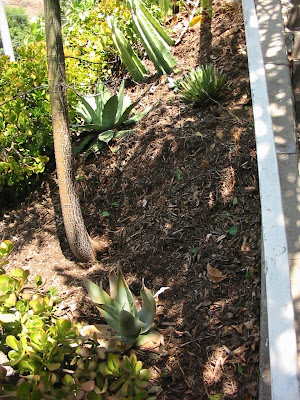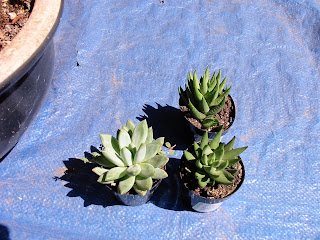So if you haven't heard, I live on a big dusty hill. I actually find this pretty charming. It's nice to live in the middle of Los Angeles but still be surrounded by so much open space. The summers can be long and dry though and starting around around April, after the last rain, things start to turn brown. The difference between winter and summer can be pretty extreme.
Winter:

Summer:

Winter:

Summer:

Winter:

Summer:

For the most part I've adjusted to this. Our growing season is in the winter and most natives take the summer off to rest. I have come to appreciate the sere beauty of the hills during the hot months, but that doesn't mean that I still don't want to try to grow things on the hill. Of course almost anything will grow here if you're willing to water it, but I'm only interested in growing plants that don't need a lot of supplemental water (I'm cheap and lazy). Luckily there are lots of natives and drought tolerant plants that do well in Southern California.
You can already see a few of them in my yard. I've mentioned that my house was vacant for over a year before I moved in, so anything that required supplemental water had already been selected out. Only the plants that could survive with only winter rains were left. Surprisingly there was a lot left. All of the mature fruit trees seemed to be established enough to make it through the summers and I've already mentioned the intimidatingly successful
Solandra maxima. The jade plants also seem to have an interesting strategy where they grow and puff up with water during the winter and then in the summer when they start to shrink they bend over and lay on the ground. Then when the rains come again the prostate sections send roots straight into the ground and the branches continue to grow vertically. Using this flop and advance technique the jade has managed to cover quite a bit of territory in the yard. In the photo below if you start at the ladder and look straight up you see the grass, a lonely yucca besieged by grass, a large jade hedge, a volunteer walnut sapling, a pomegranate tree, a california pepper tree and a white sapote tree.

I appreciate the work that the jade is doing, not only looking pretty and green, but also holding up the hill. In the summer the soil is dry and crumbly and the roots do a good job holding it together. I'm happy when anything grows, as it contributes to the security net holding the hill in place.
That being said, I'm also hoping to add more diversity as the garden evolves. I would love to start incorporating more sages, manzinitas, lavendar and echium, but those cost money. Unlike these:

In the center of this photo are a few
Agave americana. These were offsets from a large clump of mature plants on another dusty hill.
A. american grows all over L.A. and obviously does well in our climate. There are a few places in my little valley where you can tell that they've been growing for years without anyone tending them. There is one giant specimen on the hill opposite my house that I've been admiring for years. I must be 6' x 6' and stands all by itself on an otherwise empty slope.
I was impressed with the way my army of little agaves was growing until my friend Holly mentioned that she had a bunch of offsets that I was welcome to, but if I wanted them I better come soon before they got too big. Too big? Who could think such a thing? Then I saw them. She had moved some small plants to the back corner of her garden when she moved in 8 years ago. That had been long enough for the babies to mature into big intimidated plants with spreading pups all around them. Holly wanted to keep the planting simple with just the 4 main plants with maybe a pup or two to replace them when they finally bloomed.
I didn't think to get a picture until I was wedge between the thorny leaves trying to dig the pups out. I admit that it was kind of scary standing on a slippery hill with so many black spikes ready to snag anything that got close.


I managed to escape with only a few scratches and it was worth it. This was my haul:

Three big feed bags of agaves, and they are big. The one below is about 5' long (I left the broom in for scale).

I planted three on the hill outside of my bedroom window. This isn't actually my yard but the person who owns the empty lot doesn't expend much effort maintaining it so I figured he wouldn't mind if I planted a couple things, you know, for soil retention. It also makes a nice focal point outside my window.

I have about 15 more that I'll put in pots until I figure out where to put them.





















































